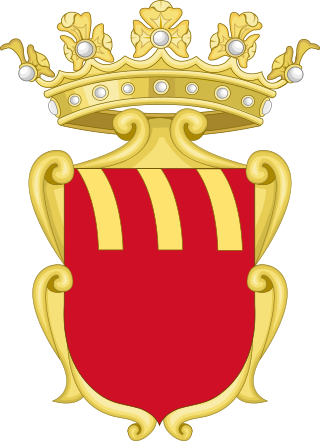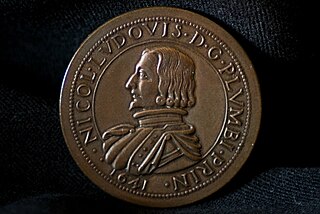Ludovisi can refer to:

Pope Gregory XV, born Alessandro Ludovisi, was head of the Catholic Church and ruler of the Papal States from 9 February 1621 to his death in July 1623.

Ludovisi is the 16th rione of Rome (Italy), identified by the initials R. XVI and located within the Municipio I.

The Ludovisi Ares is an Antonine Roman marble sculpture of Mars, a fine 2nd-century copy of a late 4th-century BCE Greek original, associated with Scopas or Lysippus: thus the Roman god of war receives his Greek name, Ares.

Casino di Villa Boncompagni Ludovisi is a historical building in Rione Ludovisi, Rome, Italy. The building is located in the former domain Villa Ludovisi.

The Gardens of Sallust was an ancient Roman estate including a landscaped pleasure garden developed by the historian Sallust in the 1st century BC. It occupied a large area in the northeastern sector of Rome, in what would become Region VI, between the Pincian and Quirinal hills, near the Via Salaria and later Porta Salaria. The modern rione is now known as Sallustiano.

Ludovico Ludovisi was an Italian cardinal and statesman of the Roman Catholic Church. He was an art connoisseur who formed a famous collection of antiquities, housed at the Villa Ludovisi in Rome.

The National Roman Museum is a museum, with several branches in separate buildings throughout the city of Rome, Italy. It shows exhibits from the pre- and early history of Rome, with a focus on archaeological findings from the period of Ancient Rome.

The House of Ludovisi was an Italian noble family, originating from Bologna. They had close ties with the Papacy and were influential in the Papal States. Alessandro Ludovisi became a cardinal and later Pope Gregory XV. His cardinal-nephew was Ludovico Ludovisi.

The Villa Ludovisi was a suburban villa in Rome, built in the 17th century on the area once occupied by the Gardens of Sallust near the Porta Salaria. On an assemblage of vineyards purchased from Giovanni Antonio Orsini, Cardinal Francesco Maria Del Monte and others, Cardinal Ludovico Ludovisi erected in the 1620s the main villa building to designs by Domenichino; it was completed within thirty months, in part to house his collection of Roman antiquities, additions to which were unearthed during construction at the site, which had figured among the great patrician pleasure grounds of Roman times. Modern works, most famously Gian Lorenzo Bernini's Pluto and Persephone, were also represented. The engraving of the grounds by Giovanni Battista Falda (1683) shows a short access avenue from a tree-lined exedra in via di Porta Pinciana and cypress-lined avenues centered on each of the facades of the main villa, laid out through open fields, the main approaches to both the villa and the Casino dell'Aurora converging on gates in the Aurelian Walls, which formed the northern bounds of the park; symmetrical parterres of conventional form including bosquets peopled with statuary flanked the main avenue of the Casina, and there was an isolated sunken parterre, though these features were not integrated in a unified overall plan. The overgrown avenues contrasting with the dramatic Roman walls inspired Stendhal to declare in 1828 that the Villa Ludovisi's gardens were among the most beautiful in the world.

The House of Boncompagni is a princely family of the Italian nobility which settled in Bologna in around the 14th century, but was probably originally from Umbria.

The Lordship of Piombino, and after 1594 the Principality of Piombino, was a small state on the Italian peninsula centred on the town of Piombino and including part of the island of Elba. A vassal of the Kingdom of Naples associated with the State of the Presidios and a territory of the Holy Roman Empire formed from the remnants of the Republic of Pisa, it existed from 1399 to 1805, when it was merged into the Principality of Lucca and Piombino. In 1815 it was absorbed into the Grand Duchy of Tuscany.

Niccolò I Ludovisi was Prince of Piombino from 1634 until his death.

Olimpia Aldobrandini was a member of the Aldobrandini family of Rome, and the sole heiress to the family fortune.

The over-lifesize marble Dionysus with Panther and Satyr in the Palazzo Altemps, Rome, is a Roman work of the 2nd century AD, found in the 16th century on the Quirinal Hill at the time foundations were being dug for Palazzo Mattei at Quattro Fontane. The statue was purchased for the Ludovisi collection, where it was first displayed in front of the Palazzo Grande, the main structure of the Villa Ludovisi, and by 1641 in the gallery of sculptures in the Casino Capponi erected for Cardinal Ludovico Ludovisi in the villa's extensive grounds. By 1885, it had been removed to the new Palazzo del Principe di Piombino, nearby in via Veneto. With the rest of the Boncompagni-Ludovisi collection, which was open to the public on Sundays and covered in the guidebooks, and where it had become famous, it was purchased in 1901 for the City of Rome, as the Ludovisi collection was dispersed and the Villa's ground built over at the end of the 19th century.

Palazzo Margherita, formerly Palazzo Piombino, is a palazzo on Via Veneto in Rome. The usual name references Queen Margherita of Savoy, who lived there from 1900 to 1926.

Camillo Francesco Maria Pamphili was an Italian Catholic cardinal and nobleman of the Pamphili family. His name is often spelled with the final long i orthography; Pamphilj.
Orazio Ludovisi (1561–1624) was an Italian nobleman, military commander and patrician of Bologna. During his brother's reign as Pope Gregory XV, he became Commander of the Papal Armies and Duke of Fiano and Zagarolo.
Boncompagni is a noble Italian family.
Ignazio Gaetano Boncompagni-Ludovisi was a priest and cardinal of the Roman Catholic Church.